Manipuri dance, one of the Indian classical dance forms, named after the region of its origin – Manipur, a state in northeastern India, is particularly known for its Hindu Vaishnava themes, and exquisite performances of Raslila, love-inspired dance drama of Radha-Krishna. Like all classical Indian dances it traces its roots in the ancient Hindu Sanskrit text Natya Shastra, but with influences from the culture fusion between India and southeast Asia. As is the case with most Indian performing arts Manipuri dance aims to express the deeper spiritual values.
The Manipuri dance drama is marked by a graceful, fluid, sinuous performance with greater emphasis on hand and upper body gestures. It is accompanied with sankirtan, devotional music created with many instruments, with the beat set by cymbals (kartal or manjira) and double-headed drum (pung or Manipuri mrdanga). The unique costumes and aesthetics make this dance a delight for the audience.
As per the tradition of the Manipuri people in the Himalayan foothills and valleys connecting India to Burma, they are the Gandharvas (celestial musicians and dancers) in the ancient Hindu texts. Historic texts of Manipuri people calls the region as Gandharva-desa. The Mahabharata mentions Manipur where Arjuna meets and falls in love with Chitrangada. The Vedic Usha, the goddess of the dawn, is a cultural motif for Manipuri women, and in the Indian tradition, it was Usha who created and taught the art of feminine dance to girls. This oral tradition of women’s dance is celebrated as Chingkheirol in the Manipuri tradition. (Wikipedia)
For this month’s photo-feature we are happy to showcase some pictures taken at a Manipuri dance performance at Auroville. This was a SPICMACAY event, an organisation aimed at promoting the appreciation of Indian classical music, art and culture among the youth. All photographs by Suhas Mehra. Introductory text and selection of quotes by Beloo Mehra.
The words of the Mother and Sri Aurobindo are offered here as aids for the readers to meditate and contemplate upon ALL that is Sri Krishna.
Krishna represents both the universal Godhead and the immanent Godhead, he whom one can meet within one’s being and in all that constitutes the manifested world. (The Mother, Words of the Mother – III, CWM, Vol. 15, p. 14)
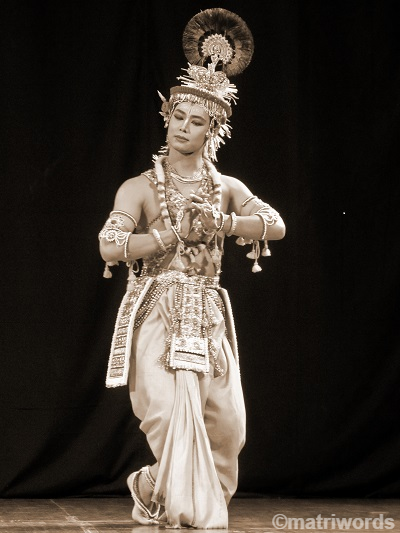
Radha’s consciousness symbolises perfect attachment to the Divine. (ibid, p. 15)
Krishna with Radha is the symbol of the Divine Love. The flute is the call of the Divine Love; the peacock is victory. (Sri Aurobindo, Letters on Yoga – I, CWSA, Vol. 30, p. 157)
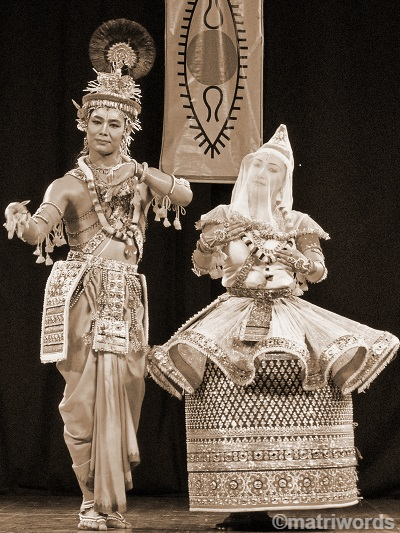
Krishna is the Eternal’s Personality of Ananda; because [of] him all creation is possible, because of his play, because of his delight, because of his sweetness. (Sri Aurobindo, Essays Divine and Human, CWSA, Vol. 12, p. 208)
Radha is the personification of the absolute love for the Divine, total and integral in all parts of the being from the highest spiritual to the physical, bringing the absolute self-giving and total consecration of all the being and calling down into the body and the most material Nature the supreme Ananda. (Sri Aurobindo, Letters on Yoga-II, CWSA, Vol. 29, p. 494)
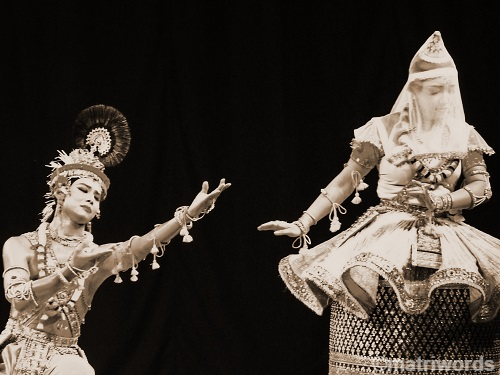
Krishna is the immanent Divine, the Divine Presence in everyone and in all things. He is also, sovereignly, the aspect of Delight and Love of the Supreme; he is the smiling tenderness and the playful gaiety; he is at once the player, the play and all his playmates. And as both the game and its results are wholly known, conceived, willed, organised and played consciously in their entirety, there can be room for nothing but the delight of the play. Thus to see Krishna means to find the inner Godhead, to play with Krishna means to be identified with the inner Godhead and to share in his consciousness. When you achieve this state, you enter immediately into the bliss of the divine play; and the more complete the identification, the more perfect the state. (The Mother, On Thoughts and Aphorisms, CWM, Vol. 10, p. 51)


Some say Krishna never lived, he is a myth. They mean on earth; for if Brindavan existed nowhere, the Bhagavat could not have been written. (Sri Aurobindo, Aphorisms, #37, CWSA, Vol. 12, p. 427)
Question asked to the Mother: Does Brindavan exist anywhere else than on earth?
The Mother: The whole earth and everything it contains is a kind of concentration, a condensation of something which exists in other worlds invisible to the material eye. Each thing manifested here has its principle, idea or essence somewhere in the subtler regions. This is an indispensable condition for the manifestation. And the importance of the manifestation will always depend on the origin of the thing manifested.
In the world of the gods there is an ideal and harmonious Brindavan of which the earthly Brindavan is but a deformation and a caricature.
Those who are developed inwardly, either in their senses or in their minds, perceive these realities which are invisible (to the ordinary man) and receive their inspiration from them.
So the writer or writers of the Bhagavat were certainly in contact with a whole inner world that is well and truly real and existent, where they saw and experienced everything they have described or revealed.
Whether Krishna existed or not in a human form, living on earth, is only of very secondary importance (except perhaps from an exclusively historical point of view), for Krishna is a real, living and active being; and his influence has been one of the great factors in the progress and transformation of the earth. (On Thoughts and Aphorisms, CWM, Vol. 10, pp. 60-61)
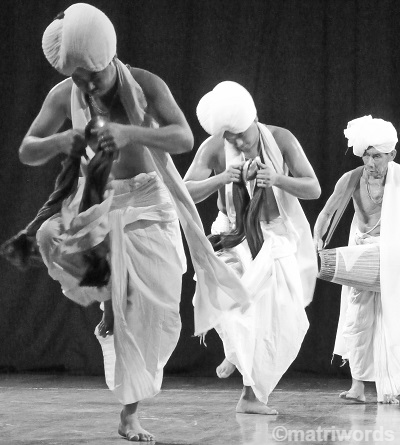

God has so arranged life that the world is the soul’s husband; Krishna its divine paramour. We owe a debt of service to the world and are bound to it by a law, a compelling opinion, and a common experience of pain and pleasure, but our heart’s worship and our free and secret joy are for our Lover. (Sri Aurobindo, Aphorism # 463, CWSA, Vol. 12, p. 487)
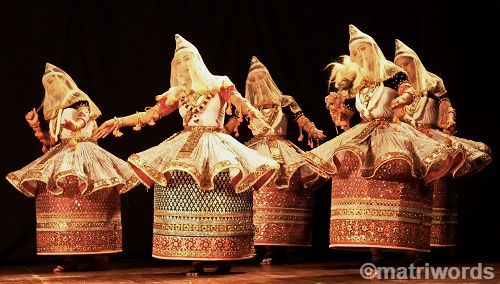
The Gopis are not ordinary people in the proper sense of the word—they are extraordinary by their extremeness of love, passionate devotion, unreserved self-giving. Whoever has that, however humble his position in other respects, learning, external sanctity etc. etc., can easily follow after Krishna and reach him; that seems to me the sense of the symbol of the Gopis. There are many other significances, of course—that is only one among the many. (Sri Aurobindo, Letters on Yoga-II, CWSA Vol. 29, p. 493)

He who recognises not Krishna, the God in man, knows not God entirely; he who knows Krishna only, knows not even Krishna. Yet is the opposite truth also wholly true that if thou canst see all God in a little pale unsightly and scentless flower, then hast thou hold of His supreme reality. (Sri Aurobindo, Aphorism # 159, CWSA, Vol. 12, p. 443)


Wow. Those are beautiful. Thanks for giving an insight on Manipuri dance form. I love Indian classical dances, being a trained Bharatnatyam dancer myself. 🙂
LikeLiked by 1 person
Glad you enjoyed reading about the Manipuri dance, Shalini! I really enjoy watching this supremely graceful dance form. Thanks for stopping by.
LikeLike
This is so beautifully elaborated on, Beloo. Has transported me to a zone of peace.
Indeed, the depiction of Krishna and Radha in a dance is one of the loveliest displays of unison. It has often been said that the two get so deeply engulfed in each other during a dance that their movements become indistinguishable.
Thank you for sharing this. Going to share it with followers of spirituality whom I know.
LikeLiked by 1 person
Thank you Vishal for your delightful comment. I am so happy that this post could create some inspiring moments of peace and quiet. You are so right, experiencing the Divine Love of Krishna and Radha in music, dance, poetry or any art can be absolutely mesmerising if we are inwardly ready to feel and receive the spirit of that performance or creative work. I still remember how wonderful I felt witnessing this particular performance whose pictures are shared here! Words fall short to describe that feeling.
Really appreciate your thought here! Thank you!
LikeLiked by 1 person
Delighted to know this beautiful tradition of Manipur
LikeLiked by 1 person
Thank you for stopping by! Glad you enjoyed the post.
LikeLike
A truly divine post! (and it’s not only due to my love for Krishna)
The pictures are breathtakingly beautiful and the quotes add so much grace and meaning to them..
A big thank you Beloo:)
I regret SPICMACAY’s absence in my town in recent years..they used to perform here in the 80’s very frequently:(
LikeLiked by 1 person
So happy to know that this post resonated so deeply with you, Amit! I do hope SPICMACAY will begin hosting some of their programs in your town, this is one organisation that has been doing stupendous work for Indian arts.
And sorry for this much delayed reply, life took me away from blogging for a while.
LikeLike
Very nice collection of pictures. One other aspect that comes out is that of continuity and reccontextualization prevalent in Indian thought – in ancient times, Gandharvas referred to Afghan people – later it was recontextualized to a Manipuri scenario, I would imagine. Just as when Saraswati dried, She was re-imagined in Triveni Sangam.
LikeLiked by 1 person
That’s a great point you bring up here, Subhodeep! Thank you. Indeed such continuity and recontextualization helps the tradition renew and rejuvenate itself and at the same time enriching itself with new lights.
Glad you enjoyed the pictures. I am sorry for this much delayed reply, just was away from the blogging scene.
LikeLike